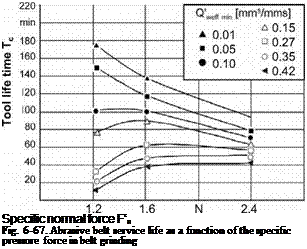The primary variable of this variant is normal force with which the workpiece is pressed against the grinding belt. The depth of cut is a result of the amount of pressure force, the abrasive belt’s topography, the component material and other process variables like the cutting and workpiece speeds.
The pressure force is related to the grinding width on the analogy of the cutting forces in grinding with discs in order to make possible comparative observations between various experimental results.
In the case of manual grinding, the user adjusts by feeling the normal force to the condition of wear of the belt. Automated grinding machines work either with constant normal force or with one which varies during grinding in accordance with a given profile. For sharp abrasive belts, the material removal rate increases along with the normal force [FROM92]. The reason for this is that the grain penetrates
more deeply into the material with increasing normal force, and the chip thickness goes up. The chip thickness, increasing with the normal force, also causes a high surface roughness.
 |
The cutting properties of an abrasive belt change during its service life. Corresponding to Fig. 6-66 at constant normal force the depth of cut and material removal rate decrease degressively over time [FROM92].
This is caused by the smaller depth of cut with increasing grain wear. The grits are initially very pointed and angular, have many sharp cutting edges and penetrate deeply into the workpiece material even at a small normal force. Large chip thicknesses arise in this way. With increasing engagement time, the cutting edges are quickly blunted. Those cutting edges that have a somewhat larger rounding radius are however more stable, so that the flattening of the grain over the duration of grinding converges similar to an exponential function. The grains as they get blunt no longer penetrate as far into the workpiece material and create smaller chips; the material removal rate is decreased.
Conflicting reports have been made in the literature about the course of surface roughness. In general, we can expect an improvement of the surface quality with increasing grinding time. It is very disadvantageous that the material removal rate sinks across the duration of belt engagement, increasing the grinding time. Meas
ures are thus sought with which the material removal rate can be held constant. One such measure is, as mentioned, changing — usually defined increasing — the normal force. One must here take care that other process parameters, e. g. surface roughness, remain within predetermined boundaries.
Economical grinding results can be obtained with constant normal force as well if the optimal pressure force is chosen at the start of the belt engagement. This requires knowledge of the service life behaviour of abrasive belts as a function of the normal force. This is elucidated by the example shown in Fig. 6-67.
vc = 25 m/s vw = 15mm/s
A — HK 80 Jot — b1
350 x 50; 64 Shore A not profiled
Material
Ck 15
In belt grinding with constant pressure force, the valid service life criterion is the minimal material removal rate which can still be considered cost effective [PAHL74]. With low material removal rates, the service life diminishes with increasing normal forces, while they go up with high material removal rates. The reason for this is the abrasive wear that, at lower pressure forces, is concentrated on the grains protruding the farthest. The periphery of the belts becomes levelled. More dull cutting edges with smaller chip thicknesses are engaged, and the material removal rate sinks. With higher normal forces, grain splintering becomes a more significant factor than dulling. New sharp cutting edges crop up constantly that cut the material more easily than dull grains.
Which wear mechanism should be preferred by choosing a service life criterion and pressure force with respect to an optimally economical machining process depends essentially on the operating conditions. Especially important is the relation of tool changing costs and machine costs as well as the question of whether dull abrasive belts can still be utilised for other tasks requiring, for example, lower material removal rates, but low surface roughness.
The effect of the cutting speed in belt grinding with constant pressure force is also comparable to grinding with grinding wheels. If the reliable amount of load
on grain and bond is not exceeded, an increase in the cutting speed results in higher material removal rates, higher workpiece temperatures and lower surface roughness.

